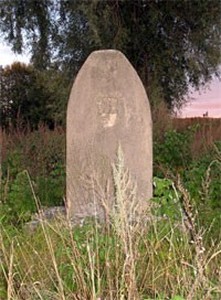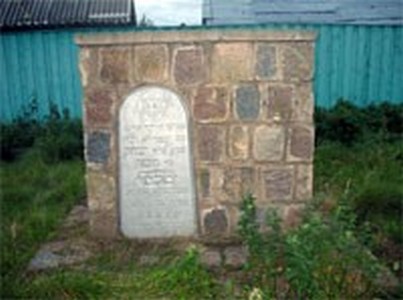Dr. Inna Gerasimova
SEARCH OF WITNESSES.
PROJECT “STONES AND MEMORY”.
BUDSLAV VILLAGE, MYADEL DISTRICT
There were little data on the places of the liquidation of Jews in the village of Budslav, Myadel district, and the data were contradictory. Only the trip to Budslav and ongoing collaboration with the villagers and a local school teacher, Irina Eduardovna Gayduk, made it possible to fix the places where Jews were exterminated and to record memories of witnesses.
There are two such places in the village. One of them is in the centre of the village, on Zelyonaya Street, near the pharmacy, the second one is not far from the Catholic cemetery.
According to one of the witnesses, Anna Stepanovna Grishkevich (born in 1928), there was a ghetto in the village. The first group of Jews (over 300 people) were gathered in the autumn of 1941 and convoyed to the cemetery to be shot. Tailors, shoemakers, pharmacists and other professionals were gathered in 1942, not far from the place where Anna Grishkevich and her parents lived. She remembers that all of them (over 70 people) were forced into the garden, ordered to undress and killed. The Germans were shooting from the windows of the house opposite the garden, practicing fire precision.
 Budslav. Monument
Budslav. Monument
to the Jews who perished.
Near the Catholic cemetery.
Sofia Iosifovna Budko, who was 9 at that time, remembered perfectly that after killing a large number of Jews, the remaining part lived in the building, located on the corner of the ghetto. She remembered that the pharmacist had three sons and a very beautiful daughter, named Balya. The Jews knew that they would soon be shot. That day Balya put on a very beautiful dress and went to the church. She might have thought that she would hide there, but a German officer went after her and took her out. On their way to the garden, as some people saw, she was trying to put something into her mouth, but the officer didn’t let her do it. She may have wanted to take poison, since she worked in the pharmacy with her father. They all were forced to undress and were quickly shot. Then the Germans ordered the Belarusians to fill up the pit, but ground was moving for a long time after. Some children went barefoot on the covered pit, but ran away quickly because the ground was still warm.
The story of the monuments to the Jews who perished in Budslav is not a simple one. We found out that the monument near the cemetery, with no inscription on it, but, most likely with an image of candles or a letter similar to “shin” but with an extra letter character, was erected by a Jew, who some people called Levitan Shmuel in the 1950s. (This name is on the list of the victims published in the Memory Book). People told that he managed to escape from the ghetto, but his family died. After the war he returned to the village, got married, and set up a monument to the dead not far from the Catholic cemetery. Then the family left the village. There’s information that he went to Kaunas and took his housekeeper, who had for many years helped them. Her name was Teresa Korchevskaya. Now her cousin, who still lives in the Budslav, is searching for her.
 Budslav. The place
Budslav. The place
of shooting on Zelyonaya Street.
The story of the second monument on Zelyonaya Street near the pharmacy is more complicated. According to the data obtained from the residents of Budslav and confirmed by the former Chairman of the village council, Ch. S. Lyashkovich, there was a simple monument on the site of the second shooting in the garden at the pharmacy. That monument began to go wreck. One day a man from Israel came to Budslav and asked to make a plank and put in the same place with the monument to the dead. Lyashkovich agreed. The plank was made, the Chairman called to Sholom Yakir, the representative of the Jewish Agency in Minsk, who later came together with Leonid Levin, the Chairperson of the Jewish Community, to set up that new plank. Everything was done as Minsk advised.
However, the plank has the name of one man, Meltzer. And what about the rest? There’s no even a mentioning that the place is the site of mass execution with over 70 Jews killed. The confirmation to this fact is in the book “Memory. Myadel District” (published in Minsk, 1998 (p. 194)). The book gives a partial list of murdered Jews of the Budslav village (pp. 318-320). Unfortunately, the photo of the old monument with the inscription in “unknown language” hasn’t been found so far. The locals say there was number “74” on the monument. I hope that someone from the former residents of Budslav or their children, who know the story of extermination of Jews in this place, will be able to help us. There is a chance that Sh. Yakir might have taken the photo of this old monument before it was completely rebuilt.
Our visit to Budslav proved to be fruitful. We’ve managed to clearly identify the locations of the monuments, take photographs, record memories of the local residents, and, what’s more important, to raise the interest of the local schoolchildren and their teachers to the history of the Jews of his village. For several months they have been recording memories of the aged residents about the Holocaust in their village.
|

